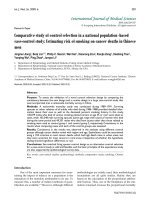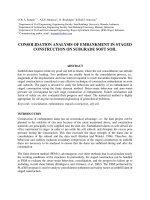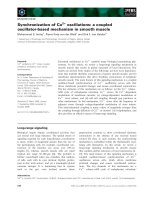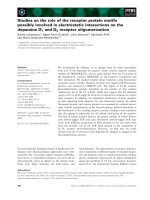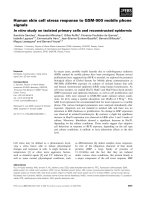Communication control mechanism in reconfiguration network on chip architectures
Bạn đang xem bản rút gọn của tài liệu. Xem và tải ngay bản đầy đủ của tài liệu tại đây (2.71 MB, 73 trang )
VIETNAM NATIONAL UNIVERSITY HANOI
UNIVERSITY OF ENGINEERING AND TECHNOLOGY
THI-THUY NGUYEN
COMMUNICATION CONTROL MECHANISM IN
RECONFIGURABLE NETWORK-ON-CHIPS
ARCHITECTURES
MASTER’S THESIS OF
ELECTRONICS – TELECOMMUNICATIONS
TECHNOLOGY
Hanoi - 2015
VIETNAM NATIONAL UNIVERSITY HANOI
UNIVERSITY OF ENGINEERING AND TECHNOLOGY
THI-THUY NGUYEN
COMMUNICATION CONTROL MECHANISM IN
RECONFIGURABLE NETWORK-ON-CHIPS
ARCHITECTURES
Branch: Electronics – Telecommunications Technology
Major: Electronics Engineering
Code: 60520203
MASTER’S THESIS OF
ELECTRONICS – TELECOMMUNICATIONS
TECHNOLOGY
Supervisor: Assoc. Prof. Xuan-Tu Tran
Hanoi - 2015
1
AUTHORSHIP
“I hereby declare that the work contained in this thesis is of my own and has not been previously
submitted for a degree or diploma at this or any other higher education institution. To the best
of my knowledge and belief, the thesis contains no materials previously published or written by
another person except where due reference or acknowledgement is made.”
Signature:………………………………………………
2
TABLE OF CONTENTS
AUTHORSHIP .................................................................................................................. 1
TABLE OF CONTENTS .................................................................................................. 2
List of Figures .................................................................................................................... 5
List of Tables ...................................................................................................................... 8
List of Abbreviations ......................................................................................................... 9
INTRODUCTION ........................................................................................................... 10
.......................................................................................................................... 12
NETWORK-ON-CHIP ................................................................................................... 12
1.1. Basic concepts ......................................................................................................... 12
1.1.1. Basic components of a NoC.............................................................................. 12
1.1.2. Network topology ............................................................................................. 13
1.1.3. Communication protocol .................................................................................. 15
1.1.4. Routing modes .................................................................................................. 16
1.1.5. Buffering strategies .......................................................................................... 17
1.1.6. Routing algorithms ........................................................................................... 19
1.1.7. Data blocking ................................................................................................... 19
1.1.8. Quality of the service ........................................................................................ 21
1.2. Communication mechanism in NoC ....................................................................... 21
1.2.1. Definition and classification ............................................................................ 21
1.2.2. Previous works ................................................................................................. 24
1.3. Reconfigurable NoCs .............................................................................................. 27
1.4. Conclusions ............................................................................................................. 29
.......................................................................................................................... 30
PROPOSED COMMUNICATION CONTROL MECHANISM IN
RECONFIGURABLE NOCS ARCHITECTURES ..................................................... 30
2.1. Target reconfigurable NoC architectures ................................................................ 30
3
2.1.1. General parameters .......................................................................................... 30
2.1.2. RNoC platform ................................................................................................. 31
2.2. Proposed Communication control mechanism ....................................................... 33
2.2.1. Tracking and replacing routing information mechanism................................. 36
2.2.2. Flit structures ................................................................................................... 37
2.3. Conclusions ............................................................................................................. 40
.......................................................................................................................... 41
ARCHITECTURE OF MODIFIED ROUTER AND NETWORK INTERFACE ... 41
3.1. Modified architecture for reconfigurable network router ....................................... 41
3.2. NI architecture ........................................................................................................ 45
3.2.1. C2r_buffer ........................................................................................................ 45
3.2.2. C2r_controller .................................................................................................. 46
3.2.3. Flitizer .............................................................................................................. 47
3.2.4. Routing_table ................................................................................................... 49
3.2.5. Updating _path ................................................................................................. 50
3.2.6. R2c_buffer ........................................................................................................ 51
3.2.7. R2c_controller .................................................................................................. 51
3.2.8. De_flitizer ......................................................................................................... 52
3.3. Conclusions ............................................................................................................. 53
.......................................................................................................................... 54
VERIFICATION, IMPLEMENTATION AND EVALUATION ............................... 54
4.1. Verification method ................................................................................................ 54
4.1.1. Verifying basic function of NI .......................................................................... 55
4.1.2. Verifying the mechanism of tracking and replacing routing information ........ 56
4.2. Implementation result ............................................................................................. 61
4.3. Evaluation ............................................................................................................... 62
4.4. Conclusions ............................................................................................................. 64
CONCLUSIONS .............................................................................................................. 65
Publications ...................................................................................................................... 67
References......................................................................................................................... 68
4
Appendix .......................................................................................................................... 70
5
List of Figures
Figure 1-1: An example architecture of a 2D mesh.................................................................. 13
Figure 1-2: Popular NoC topologies: (a) ring and chordal ring; (b) fat-tree; butterfly fat-tree;
(d) 2D-mesh; (e) 2D-torus; (f) 2D folded torus [5]. ................................................................. 14
Figure 1-3: Three frequent routing modes of NoC: (a) Store And Forward; (b) Virtual Cut
Though; (c) Wormhole [5]. ...................................................................................................... 16
Figure 1-4: Four popular buffering strategies of NoC: (a) Input queuing;(b) Output
queuing;(c) Virtual output queuing;(d)Virtual channel priority input queuing [5]. ................. 18
Figure 1-5: Deadlock example [5]. ........................................................................................... 20
Figure 1-6: Separated buffer virtual channels are used to solve the deadlock problem. The data
of one VC can use the physical link when the others one in the same port is stalled[4].......... 20
Figure 1-7: An example of livelock. The ouside routers can’t reach the inside once because
they are in deadlock [5]. ........................................................................................................... 21
Figure 1-8: The classification of NOC’s flow cotrol mechanisms. .......................................... 22
Figure 1-9: Connection implementation of end-to-end flow control [13]. ............................... 24
Figure 1-10: NoC architecture with injection level flow control strategy [14]. ....................... 25
Figure 1-11: Router architecture [15]. ...................................................................................... 26
Figure 1-12: Proposed idea of T-error [12]. ............................................................................. 27
Figure 1-13: Logic level of T-error [12]................................................................................... 27
Figure 2-1: RNOC router architecture [2]. ............................................................................... 31
Figure 2-2: (a) Probihited router is in the middle of a straight segment routing path, (b) the
probihited router is at the conrner of routing path [2]. ............................................................. 32
Figure 2-3: The prohibited router appears just before or just after the corner of the routing
path [2]...................................................................................................................................... 33
Figure 2-4: Block diagram of proposed communicaiton mechanism....................................... 34
Figure 2-5: Router-to-router/NI interface and send/accept protocol [23]. ............................... 35
Figure 2-6: A flow diagram of the tracking and replacing routing information mechansim. .. 37
Figure 2-7: Structure of header flit ........................................................................................... 38
6
Figure 2-8: Structue of body flit of a normal packet. ............................................................... 39
Figure 2-9: A structue of body flit of a special packet. ............................................................ 39
Figure 2-10: A structue of tail flit............................................................................................. 39
Figure 3-1: Micro-architecture of INPUT PORT of RNOC’s router [2]. ................................ 42
Figure 3-2: Modifying the VC_Demux of the North input port ............................................... 43
Figure 3-3: Modifying the VC_Demux of the East input port ................................................. 44
Figure 3-4: Modifying the VC_Demux of the South input port ............................................... 44
Figure 3-5: Modifying the VC_Demux of the West input port ................................................ 44
Figure 3-6 : A architecture of NI. ............................................................................................. 45
Figure 3-7: C2R_buffer module. .............................................................................................. 46
Figure 3-8: C2R_controller module. ........................................................................................ 47
Figure 3-9: Flitizer module. ...................................................................................................... 48
Figure 3-10: Routing table module. .......................................................................................... 49
Figure 3-11: Updating path module. ........................................................................................ 50
Figure 3-12: R2C_Buffer module. ........................................................................................... 51
Figure 3-13: R2C_controller module. ...................................................................................... 52
Figure 3-14: De_flitizer module. .............................................................................................. 53
Figure 4-1 Testbench model. .................................................................................................... 55
Figure 4-2: Test case 1.............................................................................................................. 56
Figure 4-3: Simulation for tracking phase and processing phase in test case 1. ...................... 57
Figure 4-4: Simulation for replacing phase in test case 1......................................................... 57
Figure 4-5: Test case 2.............................................................................................................. 58
Figure 4-6 Simulation for tracking phase and processing phase in test case 2. ....................... 59
Figure 4-7: Simulation for replacing phase in test case 2......................................................... 59
Figure 4-8: Test case 3.............................................................................................................. 60
Figure 4-9: Simulation for tracking phase and processing phase in test case 3. ...................... 61
7
Figure 4-10: Simulation for replacing phase in test case 3....................................................... 61
Figure 4-11: Timing information.............................................................................................. 62
Figure 4-12: ASIC & VLSI design flow [24]. .......................................................................... 70
8
List of Tables
Table 2-1: Function and code for each type of flits .................................................................. 38
Table 3-1: Codes for directions ................................................................................................ 43
Table 3-2: Code for VC_Demux of each input port. ................................................................ 43
Table 3-3: Pin desciption of C2R_buffer module .................................................................... 46
Table 3-4: Pin desciption of R2c_buffer module ..................................................................... 51
Table 4-1: Routing informaton in test case 1 ........................................................................... 57
Table 4-2: Routing information in test case 2 .......................................................................... 58
Table 4-3: Rouiting information in test case 3 ......................................................................... 60
Table 4-4: Device Utilization Sumary (estimated values)........................................................ 61
Table 4-5: Delay information ................................................................................................... 63
9
List of Abbreviations
ASIC
Application-Specific Integrated Circuit
CCM
Communication Control Mechanism
FIFO
First In First Out
FPGA
Field Programmable Gate Array
IP
Intellectual Property
NoC
Network on Chip
QoS
Quality of Service
SAF
Store -And-Forward
SoC
System on Chip
VC
Virtual Channel
VCPIQ Virtual Channel Priority Queuing
VCT
Virtual Cut Through
VHDL
VHSIC Hardware Description Language
VHSIC Very High Speed Integrated Circuit
VOQ
Virtual Output Queuing
WH
Wormhole
10
INTRODUCTION
To meet the quickly increasing in demand of applications, more and more
computing resources such as Central Processing Units, Digital Signal Processors, and
particular Intellectual Property (IP) cores are added into a System-on-Chip (SoC).
Therefore, interconnection between these computing resources become a big challenge
in SoC. Network-on-Chip (NoC) have recently emerged as a promising solution for
communication in large SoCs. The NoC architecture provides a new method for
connecting of different IP-cores through an effective, modular, and scalable network
[1]. However, standard NoCs architectures seem not flexible enough to support dynamic
environment where communication characteristics can strongly changing at run-time. A
new NoC design methodology called reconfigurable NoCs emerges an alternative
solution to tackle current challenges. Reconfigurable NoCs have the ability to provide
adaptive communication infrastructures and the flexible network protocols [1].Thanks
to dynamically reconfiguring hardware ability, reconfigurable NoCs allow many
hardware tasks to be mapped onto the same hardware platform.
There are several proposed reconfigurable NoCs, and each architecture has a
different method to make NoC reconfigurable. Depending on the characteristic and
features of each reconfigurable NoC, communication infrastructures and
communication protocol change adaptively after the reconfiguring process. As be a part
of the communication protocol, the communication control mechanisms (CCM) also
need to be updated with a new environment to ensure the correct operation as well as
the communication performance of the network. The RNoC [2] is a reconfigurable NoC
platform developed at the key laboratory for Smart Integrated Systems (SIS lab), VNU
University of Engineering and Technology. It provides a router architecture which can
reconfigure the routing path when the being transmitted data face to prohibited node (i.e,
dead node). However, the routing path reconfiguration process leads to an increase in
packet delay. In the other words, the process of reconfiguration lengthens the period the
packet occupy communication resources and thus affect to network traffic. Therefore,
we will propose a CCM for the RNoC platform to guarantee the lossless communication
as well as reduce the packet delay of the network.
11
In our CCM, both the node-to-node flow control and the end-to-end flow control
are used to reach the target. While the node-to-node flow control ensures the lossless
communication of RNoC, the end-to-end flow control is responsible for updating the
CCM after reconfiguration process. The main part of our end-to-end flow control is the
tracking and replacing information mechanism. To implement our tracking and
replacing information mechanism, the RNoC architecture will be modified to support
the tracking phase while NI architecture is designed to implement the processing phase,
replacing phase. Our NI design is modeled by using VHDL language. Then our NIs are
plugged into a 4×4 mesh modified RNoC platform for simulating and verifying the
operation of our CCM. The simulation results show that our CCM helps NoC decrease
about 23.5% to 50% in header-to-header delay, 0% to 50% in tail-to-tail delay and 5.2%
to 11.7% in packet-to-packet delay. After the verification process, our NI architecture is
synthesized to kit Virtex5 XC5VLX330 -2ff1760 using tools of Xilinx. The result of
synthesis process gives that our design can operate at a maximum frequency of 294MHz.
The thesis is organized into four chapters, the Introduction section and
Conclusion section. Chapter 1 will give an overview of the NoC and its basic concepts.
Besides, the communication mechanism in NoC and reconfigurable NoCs are also
reviewed in this chapter. Chapter 2 is about our proposed communication control
mechanism for reconfigurable NoC architectures. Then, the modified architecture of
RNoC router and our NI design are described in Chapter 3. In Chapter 4, the method to
simulate and verify our design will be explained. The implementation results and the
evaluation are also given in chapter 4. Finally, conclusions section will summarize the
work presented and give the future work which far related.
12
NETWORK-ON-CHIP
In this chapter, we will address on basic concepts of network-on-chip (NoC)
paradigm. Then the communication control mechanism will also be presented. Finally,
some previous works will be reviewed and discussed to provide the state of the art of
the research topic.
1.1. Basic concepts
Network on chip (NoC) is emerging as a revolutionary methodology in solving
the bandwidth bottleneck of shared bus interconnection.In this section, to give a good
overview of NoC, we will introduce main concepts of NoC paradigm. The network
topology, communication mechanisms, routing modes, buffering strategies, routing
algorithms, quality of service, flow control and data blocking are explained and
analyzed. After that, the state of the art about NoC will give the investigating trend
which the topic of this thesis is clearer.
1.1.1. Basic components of a NoC
There are three fundamental components in a Network-on-chip: Routers,
Network Interface (NI) or Network Adapter (NA) and links [3]. In NoC, routers connect
to each other through links with a specific topology. An example architecture of a 2D
mesh NoC example is shown in Figure 1-1. Each router can communicate with an IPcore through a NI.
13
Figure 1-1: An example architecture of a 2D mesh.
Links: A communication link is a set of wires. The function of links is
physically connecting routers in the network and actually implementing
the communication [3].
Router: the main function of a router is routing data from source to
destination according to chosen protocol and routing strategy [4].
Architecture of router depend on many factors such as communication
protocol, routing mode, routing algorithm, …
Network Interface (or Network Adapter): As each IP-core may have a
distinct interface protocol with respect to the network, NoCs must include
NIs which makes the logic connection between IP-cores and the routers
[3].
1.1.2. Network topology
Network topology of NoC defines how the network routers are interconnected by
channels and is usually modeled by a graph [5]. There are many topologies can be used
to implement NoC, and each of them owns advantages and drawbacks. Figure 1-2
demonstrate several examples of regular topologies used in NoC design such as: ring,
chordal ring, fat tree, butterfly fat-tree, 2D-mesh, 2D torus, 2D folded torus.
14
Figure 1-2: Popular NoC topologies: (a) ring and chordal ring; (b) fat-tree; butterfly fattree; (d) 2D-mesh; (e) 2D-torus; (f) 2D folded torus [5].
Because each network topology owns good and bad features, the following
physical parameters are usually used to make a comparison between them: router degree,
network diameter, regularity, symmetry, path diversity, and bisection width. Based on
these characteristics, the 2D mesh topology is considered as the most predominant one
because of some advantages. For instance, it is easy to be implemented by using the
current IC plane technologies, has simple routing strategies, and has network scalability.
Besides, 2D torus topology is also popular choice if the designers want to minimize the
diameter of network as well as improve its bandwidth. Nevertheless, this type of
topology has a more complex implementation, and its long wrap-around link at the
external boundary router can causes the decrease in communication performance. With
the 2D folded torus, the long wrap-around link at the external boundary router problem
is overcome, but its routing algorithm is more complex in compare with above
topologies. All of three mentioned topologies have drawback on associated network
latency.
Fat-tree topology, butterfly fat-tree topology and choral ring topology are also
the frequent option used to construct a robust NoC. Fat-tree and butterfly fat-tree
topologies are often used to get lower associated network latency thanks to their very
small diameter network. However, it has to deal with the fan-in/ fan-out and wiring
complexity problems. In compare with the ring topology, the chordal ring topology has
higher communication performance, but its wiring complexity and routing difficulty are
also increased.
15
In conclusion, there are many topologies can be used in NoC architecture, so it is
very hard to make the best decision. Moreover, constraints of the application and
network information traffic have to take into account. We always have to make a
tradeoff between intrinsic performance and the topology and its implementation
overhead.
1.1.3. Communication protocol
Communication protocol defines strategy of moving data in a NoC [4]. In fact,
the communication on network bases on the switching (known as the setting up
temporary links between two or more nodes in network to transfer information or a part
of information) techniques. There are two principle techniques usually used in NoC:
circuit-switching and package switching.
Circuit-switching: This is the first switching technique has been used in oldgeneration telephone network. When circuit-switching technique is applied, the
communication link between the source node and the destination one must be set up
before any transmission can occur. Therefore, there always exists a physic channel
between two communication units during the data transferring period. The control
information and communication information are independent.
The circuit-switching has many advantages such as high guaranty, maximum
bandwidth and low transmission latency. Therefore, it is sufficient for real time
application. Nevertheless, the circuit has to be granted before the transmission, so the
network resources will be occupied until the end of transmission. Moreover, the low
flexibility is another disadvantage of this technique, for instance, the central controller
must be repaired whenever there is router changing.
Packet-switching: In package-switching, data is encapsulated into packages at
the source before be sent to the destination. Each package is composed of successive
flits and contains the control and communication information. These flits will be
simultaneously transferred via the many different paths and rearranged then at the
destination.
Thanks to using this technique, the upper limit of possible network performance
can be reached and resources (i.e. routers, links…) can be shared. In contrast to circuitswitching, the network using this technique is locally switched between network nodes,
not the communication units. Another advantage of this switching method is no central
controller is in need because of the separately routing of packages. However, to rout
packages individually, the routing information has to be included in each package. This
lead to the drawback of package-switching is the router become more and more
16
complex. Moreover, the network has to deal with some critical problems, such as high
transmission delay, dead-lock, ordering management.
1.1.4. Routing modes
Because of the complexity of package-switching, it is necessary to define routing
mode. Routing mode is known as the way a package is forwarded from one network
node to the next one [5]. Store-And-Forward (SAF), Virtual-Cut-Through (VCT) and
Wormhole are three common routing modes of NoC.
Figure 1-3: Three frequent routing modes of NoC: (a) Store And Forward; (b) Virtual
Cut Though; (c) Wormhole [5].
Store-And-Forward (SAF): In this routing mode, all of the flits of a package
are transmitted from one router to the next one. Therefore, the buffer of each router must
be large enough to store an entire data package as represented in Figure 1-3(a). However,
the limit of implementation area and power consumption in NoC causes a narrow router
buffer space. In addition, the data delay at every routing stage will be increase and
package’s flits are not sent to the next router until all of them reach the current router.
Virtual Cut-Though (VCT): In order to reduce the package delay at every
router, the Virtual Cut-Though is proposed. In this mode, transmitting flits of one
package to the next router can be started before all of that package’s flits are received
by the current router as in the SAF mode. This is illustrated in Figure 1-3(b). However,
the current router must have capability to store the whole package in case the next router
is busy. Therefore, buffers of router using this mode have the same size with these ones
when SAF mode is applied.
17
Wormhole (WH): In this mode, a flit of one package can be forwarded whenever
the next router is available as shown in Figure 1-3(c). As in VCT mode, it is not affected
by the incompletely receiving the entire package of the current router anymore. In NoC
which using WH routing, each package includes one header flit, some data flits in the
middle and the last one called tail flit. The header flit contains the routing information
has to reserve routing channel of each router. The data flits then follow the reserved
channel which will be later released by the tail flit. In contrast to two above mode, this
routing mode reduces the buffer size of network router as much as possible. Moreover,
one package can occupy several switches at the same time, so the package latency is
reduced also. However, the main drawback of WH mode is if one flit is blocked, all of
flits flow that one will be blocked.
In computer network, SAF mode is preferred to use thanks to the large
implementing area. While in NoC, the frequent one is WH because this mode has low
data latency and small router buffers.
1.1.5. Buffering strategies
As considered, in the package-switching, routers have to store the data in their
buffers. How data buffers are arranged depending on the buffering strategy applied [5].
In this subsection, four popular buffering of NoC will be presented: input queuing,
output queuing, virtual output queuing, virtual channel priority input queuing.
Input queuing: with this strategy, N queues will be established at N inputs port
of one router, see Figure 1-4(a). A scheduling arbiter will decide which output port will
be connected to which given input at a given time to avoid the conflict problem.
However, because of the head-of-line blocking when the number input port is large, the
router traffic will be saturates at 59 %.Head-of-line blocking occur when there is head
data of queue can’t access output ports and it blocks all data flows.
18
Figure 1-4: Four popular buffering strategies of NoC: (a) Input queuing;(b) Output
queuing;(c) Virtual output queuing;(d)Virtual channel priority input queuing [5].
Output queuing: In this strategy, N queues will be located at N output ports of
each router as depictedFigure 1-4(b). All flits arrive at the same time slot must be
scheduled before the starting of the next time slot. This causes the crossbar fabric has to
run N times as fast as the input/output port work, even if all of flits have the same target
output port. This is the disadvantage of output queuing. While, the advantage of this
scheme is that it can achieve maximum throughput of one per input and the best delay
performance.
Virtual Output queuing (VOQ): The idea of this strategy is to combine the
advantages of input queuing and output queuing. From the model of input queuing
mechanism, this one locates N buffers at N input port and add (N-1) virtual buffer for
each port to eliminate the head-of-line blocking issue, so there are N2 buffer in one Ninput-ports router. Moreover, this strategy imitates the working of output queuing
strategy, so all inputs can be connected to output at the same time. Therefore, the VOQ
mechanism has high storage performance in compare with two above ones. However,
the very large number of buffers makes it become really expensive in term of
implementation area.
Virtual Channel Priority Input Queuing (VCPIQ): This strategy is proposed
to improve the switching performance and reduce the disadvantage of VOQ mechanism.
For one physical channel, we set up P queues (P < N) for P virtual channel to share the
bandwidth of the link as illustrated in Figure 1-4(a). By using virtual channel, the head-
19
of-line blocking problem is reduced, this lead to increase the capacity usage of the links.
In the other words, data latency and the complexity of switch increase with the number
of virtual channel.
1.1.6. Routing algorithms
Routing algorithm forms a path which data package is transmitted from the
source to the destination [5]. It plays an important role in communication of NoC.
Therefore, we have to analysis and tradeoff between requirements to make a sufficient
solution which can use the maximum capacity of communication nodes as well as be
simple to be implemented on NoC.
There are two main types of routing algorithms are deterministic routing
algorithm and adaptive routing algorithm [5]. In deterministic routing algorithm, the
path between the source and the destination is established without the affection of the
current state of network. While, if the NoC using adaptive routing algorithm, the setting
up of path between the source and the destination will be in tight relationship with the
network’s current state. The first type of routing algorithm is simpler than the second
one, so it is preferred to use in ASIC which usually have stable transmission data. The
adaptive routing algorithm is used in system which have unpredictable network
throughput like in MPSoC (Multi-Processor SoC).
Rely on the routing decision, we can divide routing algorithms into four subtypes
[6]: centralized routing, source routing, distributed routing and multiphase routing. With
the centralized routing, the path of data is given by the central controller. If the source
decides the routing algorithm, it called source routing. Nevertheless, the routing
decisions are made during the period when data is being transmitted from the source to
the destination. The final type, multiphase routing, is the hybrid type of source routing
and distributed routing.
1.1.7. Data blocking
Deadlock and livelock are two typical type of data blocking in NoC.
20
Figure 1-5: Deadlock example [5].
Deadlock : This type of data blocking occur when there is at least one flit blocked
because of waiting the event which can be happened. Figure 1-5 illustrates an example
about deadlock. The data occupies the link L1, L2 is waiting for the release of the link
L3, while link L1 is released if only if the L3 is not occupied. This problem can be
addressed by using virtual channel technique. The way Virtual Channel (VC) technique
works is represented in Figure 1-6. The data of one VC can use the physical link when
the others one in the same port is stalled.
Figure 1-6: Separated buffer virtual channels are used to solve the deadlock problem.
The data of one VC can use the physical link when the others one in the same port is
stalled[4].
Livelock: The case in which package can’t reach the target router while it is not
totally blocked called livelock. This occurs when resources perpetually change their
state waiting for other communication to complete [5]. One example of this phenomenon
is shown in Figure 1-7.
21
Figure 1-7: An example of livelock. The ouside routers can’t reach the inside once
because they are in deadlock [5].
1.1.8. Quality of the service
Quality of Service (QoS) are the aspects of service provided by the network to
determine the guarantees level for data transfer. There are some characteristic used to
find out the QoS of NoC, for example related to timing (minimum throughput, maximum
latency, maximum latency jitter), related to integrity (maximum error rate, maximum
package loss), and related to package delivery (the order of input or output) [7]... Depend
on these aspects, QoS of NoC is divided into two following types:
Best Effort (BE): The package will be transmitted as soon as possible and the
sized of network will be calculated to get the best average performance. However, in
general, it is not guaranteed for latency or throughput.
Guaranteed Service (GS): In contrast to BE known as the non-guaranteed
Service, this type of QoS brings to the NoC a warrant about the minimum throughput
and maximum latency. This lead to NoC using QS demands more network resource than
the one using BE [5].
1.2. Communication mechanism in NoC
1.2.1. Definition and classification
There are many control mechanisms in NoC built to ensure the correct operation
of the NoC such as: flow control mechanisms, congestion control mechanisms, error
control mechanisms, etc. In this work, we concern about communication control
22
mechanism as the flow control mechanism which briefly introduced in subsection 1.1.7.
The aim of flow control mechanism is to avoid the overloading of network and moderate
the network traffic [5].
Flow control mechanisms classification is demonstrated in Figure 1-8. Firstly,
these mechanisms can be divided into two types: end-to-end flow control and node-tonode (switch-to-switch) flow control. After that, node-to-node flow controls can be
further categorized into bufferless flow control and buffered flow control. There are
many buffered flow control techniques such as Credit Based flow control, Handshaking
signal based flow control, ACK/NACK flow control, STALL/GO flow control and Terror flow control [8, 9].
Figure 1-8: The classification of NOC’s flow cotrol mechanisms.
With respect to moderating the network traffic target, end-to-end flow control is
proposed to regulate global traffic, while node-to-node flow control have responsibility
for the local traffic (between routers). To achieve the avoid overloading of the network
aim, end-to-end flow control mechanism ensure that a source node not produce more
data than the destination node to can be address, so the buffer in NI cannot be overflow.
In addition, buffers in routers are protected using node-to-node flow control which
determine the ways the up-stream router checks the buffer’s status of down-stream one.
23
As results, end-to-end flow control is implemented in NI (or NA) while node-to-node
flow control occurs in routers. The Node-to-node flow control can be used to prevent
the buffer at NI from being overflow since the last router in routing path can
communicate with the destination NI as a normal router. It will check the status of buffer
in NI is not full, the data in the last router will be sent, and else data will be store at the
buffers in routers along routing path. However in case that the consuming operation in
destination node is slower compare to injection operation at the source node, flit/data
will be stalled across the network. This tends to cause the congestion and deadlock in
NoC [10]. Therefore, using link-level flow control without end-to-end flow control is
not recommended. In contrast, using exclusively end-to-end flow control without nodeto-node flow control is not feasible [9].
Bufferless flow control is mainly used in circuit switched networks as in works
of [11]. Argawal et.al comment that the buffer less flow control is more latency and less
throughput in comparison with the buffered one [8].In contrast to the bufferless flow
control, buffered one is used for packet switched networks. Flowing paragraphs will
give some buffered flow control.
Credit Based flow control: is a flow control mechanism where the upstream node
has a counter to track the number of available free slots in the downstream queue.
The counter state is decremented whenever a flit is transmitted and incremented
whenever a credit signal arrives from the downstream node, which in turns sends
the credit whenever it has succeeded in forwarding a flit from its queue to the next
hop.
Handshaking signal based flow control: whenever upstream node send data to
the downstream node, a valid signal is raise at the former node. As soon as
successfully receiving data, downstream node raises the valid signal to inform the
upstream node that data is consumed.
ACK/NACK flow control: in this mechanism, a copy of data which is sent to the
downstream node is deleted from the buffer of the upstream node when an ACK
signal is asserted at the downstream. In the case of receiving a NACK signal, the
upstream will schedule to retransmit that data. Thanks for the retransmission
mechanism, ACK/NACK flow control technique supports thorough fault detection
and handling.
STALL/GO: there are two wires (signals) are used to implement this flow control
mechanism: one wire going forward and another wire going backward. The former
informs that being sent data is valid while the latter is asserted either when buffer
